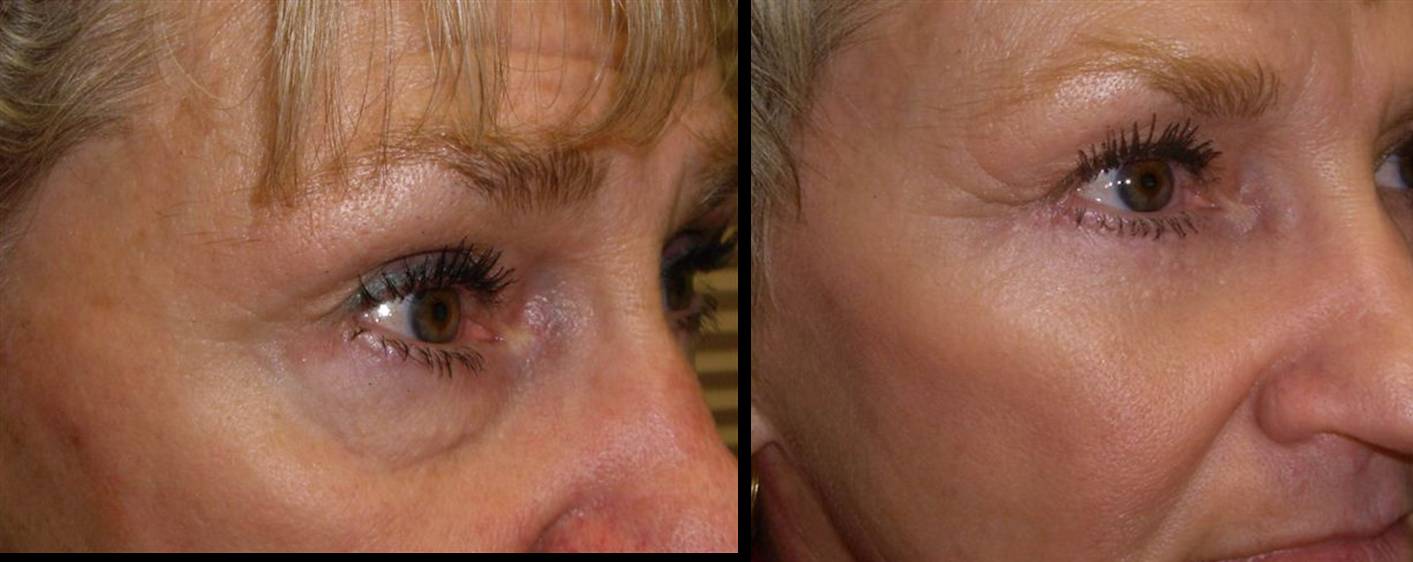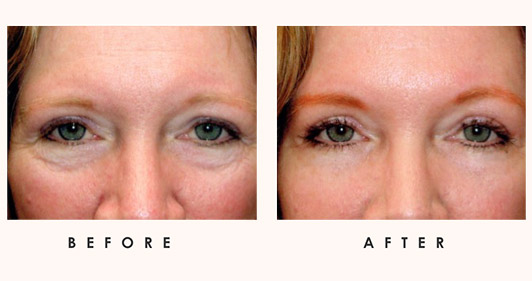Facelift with Fat Transfer
Jump To
Comprehensive Approach, Natural Results
Fat Transfers
Another procedure used to rejuvenate the mid-face is the transfer of a patient’s own fat to areas that have lost volume due to the aging process. Dr. Boerner uses this cosmetic facial surgery to smooth and repair wrinkles and creases on the face and to elevate depressions which can exacerbate the appearance of lower eyelid bags. The combination of fat transfer and blepharoplasties can produce amazing results. For example, the before/after image directly below combines lower lid blephs, fat transfer, and upper eyelid fat pad removal.
Facelift – A Comprehensive Overview
- Facelifts have proved to be uplifting experiences for thousands of individuals across all walks of life. People undergo this cosmetic procedure with the hope of regaining a bit of their youthfulness.
- Long gone are the days when only high-profile actors, politicians, or influential businessmen had access to this seemingly complex surgical procedure to improve upon their given facial features. Today, facelift procedures remain one of the most commonly performed cosmetic procedures and can boast excellent results.
What is a Facelift?
- A face-lift or rhytidectomy is a cosmetic surgical procedure of the face and neck performed to improve the loose skin that causes wrinkles or rhytids. A face-lift smooths out the loose skin over your face and neck, improving the visible signs of aging and giving you a more youthful appearance.
- Undergoing a facelift surgery is a big decision. Hence, utmost care is required in choosing your surgeon and place of surgery, as these two factors impact the outcome of your procedure.
- For a better understanding of a facelift, a little knowledge about the anatomy of the face and neck is immensely beneficial. So, here it goes!
Understanding Facial Anatomy
- Your face is made up of layers of tissues varying in texture and consistency. These tissue layers overlie the bony skull, which provides the support for and structure of your face. From a cosmetic surgeon’s standpoint, your face is made up of the following components: skin, fat, superficial musculoaponeurotic system (SMAS), platysma muscle, Erb’s point (containing important nerves), deep cervical fascia and the retaining ligaments of the face. Mastering the art of tweaking these components in the correct proportion and in an aesthetically pleasing manner is the surgeon’s delight and goal, the reward being the facial improvement that you desire.
- The thickness of skin overlying your face is variable – your eyelids have the thinnest skin while your cheeks and forehead are covered by thicker skin. Facial skin is repeatedly exposed to the sun and elements. This skin is also affected by aging, resulting in loss of elasticity and the development of rhytids or wrinkles. The skin consists of two main layers – the inner layer called the dermis and the outer layer called the epidermis. Our epidermis is what everyone sees!
- Fat is one of the most important components of your face and lies just beneath your skin, i.e. subcutaneous fat. It consists of lobules partitioned by fibrous septa which connect the inner layer of the skin, the dermis, to the superficial fascia just beneath the fat. The distribution of fat in the face is variable, with a major portion deposited right beneath your cheek as the malar fat pad. It is also found below the eyes, lateral to your nose, and in front of your ears. Fat accentuates your cheekbones nicely. The malar fat pad is propped up by connections to the orbitomalar ligament, the superficial musculoaponeurotic system (SMAS), underlying soft tissue, and bone. With age, the malar fat pad shrinks, causing the cheeks to droop towards the crease between your nose and lips. This drop in cheek tissue results in a deeper fold and shadow– a definite sign of aging.
- The SMAS or superficial musculoaponeurotic system covers and connects the muscles of facial expression to the deeper layers of your face. It lies beneath the fat layer of your skin and provides a definition to your facial expressions. The SMAS is a thin layer of connective tissue that lies attached closely to the platysma muscle, frontalis muscle, galea, and superficial temporal fascia. It is also closely attached to the superficial muscles of facial expression (including the orbicularis muscle), pre-orbicularis fat, and the malar fat pad. The SMAS is attached to bone at the infraorbital rim, zygoma, and the mandible.
- The Platysma is a thin, flat muscle that begins in the chest just in front of your collar bone, the clavicle, moving up towards the face and covering the front and sides of the neck. It eventually attaches to your jaw bone and skin, then merges with several muscles and continues as the SMAS over the parotid (salivary) gland and cheek. Both sides of the Platysma merge at the midline just below your jawline. As one age, the platysma muscle becomes loosely attached to the underlying structures resulting in vertical banding and bowing under the chin.
- The Deep Cervical Fascia is a connective tissue in the neck that covers and protects the muscles, nerves, blood vessels, and glands of the face. Surgery deep into the deep cervical fascia can result in injury to the facial nerve, which is the primary nerve supply to the face. Damage to any of its five branches could cause weakness of the muscles supplied by that particular branch. Utmost care must be taken to avoid injury to the facial nerve or its branches.
- Erb’s point lies vertically below the ear canal just behind the sternocleidomastoid muscle and represents the point of emergence of several nerves that provide sensation to the neck and lower face. It lies just over the sternocleidomastoid muscle. Its largest branch, the greater auricular nerve emerges 6.5 cm below the ear canal and provides sensations to the lower portion of the ear and area just behind the ear. Hence, it is important to meticulously dissect this area to avoid damaging any of these nerves.
Retaining ligaments or tendons provide support to the soft tissues of the face and also provide points for the movement of muscles of facial expression. The retaining ligaments important during rhytidectomy surgery are:
- Allergy or unpredicted response to anesthesia
- Infection is a possibility with any surgery but is rare.
- Bleeding and hematomas are more common. Hematomas are seen in 15 percent of cases.
- Nerve damage is rare but can occur with deeper dissections.
- Visible scars are the bane of any cosmetic surgeon. Surgeons try to keep the scars hidden from view as much as possible.
- Mild pain, sensitivity, bruising, and swelling are common after a facelift.
- Temporary numbness can occur due to sensory nerve interruption.
- Some incisions take longer to heal compared to others. Diabetes, autoimmune diseases, and lung and heart disease can all contribute to longer healing times. Diabetics should be in good control prior to and after surgery.
- Skin necrosis with sloughing is a rare complication and is seen most commonly in smokers.
- Hair loss along the hairline is common and is usually temporary. Occasionally, it is permanent and might require hair transplantation.
- Contour irregularities can occur, frequently due to too aggressive sculpting of the fat.
- Distortion of the hairline, the ear lobe, and the tragus can occur.
- Facial nerve injury is reported in 0.5 to 2.6% of facelift surgery.
Dos and Don’ts after Facelift Surgery
- Take care not to remove any dressing or drains your surgeon has placed.
- Rest at home and do only moderate work. Do not exert yourself physically, bend, carry heavy objects or exercise for 3 weeks. Walking is not restricted.
- It is natural to feel tired or weak for 7-14 days after the surgery.
- “Three pillows for three weeks” is the dictum to be followed. Try not to lie down on your side.
- Swelling maximizes during the original two days but then gradually subsides.
- Apply antibiotic ointment to the suture or staple line 3 times a day. Sutures and staples are removed in 7-14 days.
- You should avoid Vitamin E, Aspirin, or related products. It is best to ask your doctor before you take any over-the-counter medications.
- You should avoid smoking, alcohol, and flying for at least 2 weeks.
- Avoid hair dyes or perms for at least 6 weeks and wait to shower until 24 hours after surgery. The shower spray should be directed at your shoulders.
- Avoid brushing your hair forcefully for at least 7 to 10 days. Use your fingers gently to style your hair.
- You might wear a hypoallergenic cover-up after 1 week. No makeup on incision areas for at least 3-4 weeks
- Avoid the sun for six weeks as it makes you prone to skin pigmentation and irregularities.
- Avoid wearing your earrings for three weeks and wear clothes that button down the front to avoid entanglements.
- You should avoid tweezing, waxing, or bleaching your facial hair for at least a month.
- Wait for dental procedures for at least 6 weeks, unless it is an emergency and completely unavoidable.
- Don’t expect your final results for at least 3 months after the surgery.
- Be careful not to use extremely hot water for warm compresses.
by Amy Olson
How Much Does Facelift With Fat Transfer Cost?
The total cost of a facelift with fat transfer surgery is determined based on factors like your medical examinations, surgeon’s fees, hospital charges, post-surgery garments, and anesthesia. The exact techniques used will also impact cost, as will the total time needed to perform the surgery.
Schedule a Consultation
As one of the most well-regarded plastic surgeons performing facelifts with fat transfer in Boise, Idaho. Dr. Boerner is here to answer all your questions about facelifts with fat transfer. To confirm whether you are an ideal candidate for facelifts with fat transfer, contact us today to schedule your in-person consultation.




